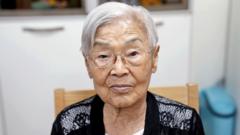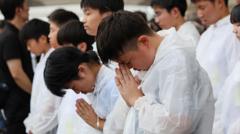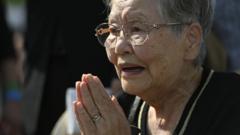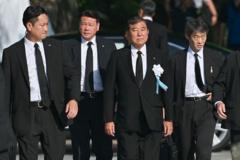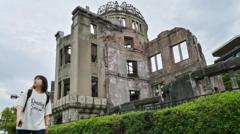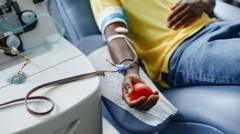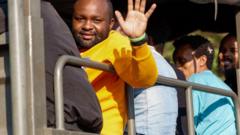The article text:
At 08:15 on August 6, 1945, as a nuclear bomb descended upon Hiroshima, Lee Jung-soon was making her way to elementary school. Now at 88, she gestures as if pushing away the haunting memories. “My father suddenly ran back to tell us to evacuate immediately," she recounts, her voice thick with emotion. "They say the streets were filled with the dead – but I just remember crying.”
The horrors of that day are etched in Ms. Lee’s mind; victims had “melted away, so only their eyes were visible” amidst the blast equivalent to 15,000 tons of TNT that devastated a city of 420,000. Approximately 70,000 people died on impact, with many more succumbing later to radiation sickness and burns. However, a critical aspect of this tragedy often overlooked is that 20% of the immediate victims were Korean.
During the years Japan occupied Korea, around 140,000 Koreans lived in Hiroshima, either as forced laborers or survivors of harsh colonial policies. The survivors, now battling health issues and discrimination, find themselves seeking peer recognition for their traumatic experiences, overshadowed by the passage of time.
Shim Jin-tae, an 83-year-old survivor, laments the lack of accountability. “No one takes responsibility,” he says. “America never apologized, Japan acts as if they don’t know, and Korea is no better. We’re left alone.” Shim and others like him now reside in Hapcheon, South Korea, an area dubbed "Korea's Hiroshima" due to its large population of survivors.
Ms. Lee and Shim embody the multiple layers of suffering stemming from that devastating day. Lee has battles with skin cancer, Parkinson’s disease, and angina, while her son suffers from kidney failure, a stark reminder of the ramifications of radiation exposure that they find hard to scientifically prove. With ongoing investigations by the Korean Ministry of Health and Welfare assessing the genetic impacts on survivors, many feel the recognition of their struggles has been delayed.
With an underlying narrative of exploitation, many Koreans were relegated to hazardous labor during the bombing's aftermath. As Mr. Shim states, “Koreans did the dangerous clean-up work,” facing greater exposure to radiation and discriminatory treatment that led to a much higher fatality rate among them.
Post-war, around 23,000 Koreans returned to their homeland, facing societal ostracization and prejudice. Branded as “damaged” and cursed, they were often stigmatized, making it difficult to share their experiences or receive recognition for their suffering.
The relentless struggles extend to the next generations, as evidenced by Han Jeong-sun, a second-generation survivor who suffers from avascular necrosis and faces scorn from her family for her son's disability. “My illness is proof,” she declares, yet the bureaucratic barriers maintain their silence.
After decades of neglect, 2019 marked a milestone with the first formal investigation by the MOHW, highlighting the lingering health ramifications and urgency. Survivors await full recognition of their identities as victims, a plea that many feel remains unfulfilled.
The recent visit by Hiroshima officials to Hapcheon represents a flicker of acknowledgment; however, activists stress an apology is necessary to heal the wounds of history. "Peace without apology is meaningless," says Junko Ichiba, emphasizing the shortcomings of Japan's dialogue regarding its colonial history and the atomic bomb's victims.
With ongoing efforts to document and honor the experiences of survivors, the call for justice prevails. Survivors like Mr. Shim insist: “Memory matters more than compensation. If we forget, it will happen again.” As time marches on, the urgency to preserve their stories becomes ever more critical.
At 08:15 on August 6, 1945, as a nuclear bomb descended upon Hiroshima, Lee Jung-soon was making her way to elementary school. Now at 88, she gestures as if pushing away the haunting memories. “My father suddenly ran back to tell us to evacuate immediately," she recounts, her voice thick with emotion. "They say the streets were filled with the dead – but I just remember crying.”
The horrors of that day are etched in Ms. Lee’s mind; victims had “melted away, so only their eyes were visible” amidst the blast equivalent to 15,000 tons of TNT that devastated a city of 420,000. Approximately 70,000 people died on impact, with many more succumbing later to radiation sickness and burns. However, a critical aspect of this tragedy often overlooked is that 20% of the immediate victims were Korean.
During the years Japan occupied Korea, around 140,000 Koreans lived in Hiroshima, either as forced laborers or survivors of harsh colonial policies. The survivors, now battling health issues and discrimination, find themselves seeking peer recognition for their traumatic experiences, overshadowed by the passage of time.
Shim Jin-tae, an 83-year-old survivor, laments the lack of accountability. “No one takes responsibility,” he says. “America never apologized, Japan acts as if they don’t know, and Korea is no better. We’re left alone.” Shim and others like him now reside in Hapcheon, South Korea, an area dubbed "Korea's Hiroshima" due to its large population of survivors.
Ms. Lee and Shim embody the multiple layers of suffering stemming from that devastating day. Lee has battles with skin cancer, Parkinson’s disease, and angina, while her son suffers from kidney failure, a stark reminder of the ramifications of radiation exposure that they find hard to scientifically prove. With ongoing investigations by the Korean Ministry of Health and Welfare assessing the genetic impacts on survivors, many feel the recognition of their struggles has been delayed.
With an underlying narrative of exploitation, many Koreans were relegated to hazardous labor during the bombing's aftermath. As Mr. Shim states, “Koreans did the dangerous clean-up work,” facing greater exposure to radiation and discriminatory treatment that led to a much higher fatality rate among them.
Post-war, around 23,000 Koreans returned to their homeland, facing societal ostracization and prejudice. Branded as “damaged” and cursed, they were often stigmatized, making it difficult to share their experiences or receive recognition for their suffering.
The relentless struggles extend to the next generations, as evidenced by Han Jeong-sun, a second-generation survivor who suffers from avascular necrosis and faces scorn from her family for her son's disability. “My illness is proof,” she declares, yet the bureaucratic barriers maintain their silence.
After decades of neglect, 2019 marked a milestone with the first formal investigation by the MOHW, highlighting the lingering health ramifications and urgency. Survivors await full recognition of their identities as victims, a plea that many feel remains unfulfilled.
The recent visit by Hiroshima officials to Hapcheon represents a flicker of acknowledgment; however, activists stress an apology is necessary to heal the wounds of history. "Peace without apology is meaningless," says Junko Ichiba, emphasizing the shortcomings of Japan's dialogue regarding its colonial history and the atomic bomb's victims.
With ongoing efforts to document and honor the experiences of survivors, the call for justice prevails. Survivors like Mr. Shim insist: “Memory matters more than compensation. If we forget, it will happen again.” As time marches on, the urgency to preserve their stories becomes ever more critical.

